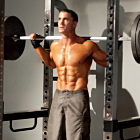 In my next few columns I’m going to dispel some of the myths I read about in magazines and online as well as hear about in the gym. This is very important to helping young trainees learn from the outset how to plan their programs properly and move in the right direction. Wasted time and energy only discourage people from continuing to pursue their physique and health goals, which is something I work quite hard to prevent.
In my next few columns I’m going to dispel some of the myths I read about in magazines and online as well as hear about in the gym. This is very important to helping young trainees learn from the outset how to plan their programs properly and move in the right direction. Wasted time and energy only discourage people from continuing to pursue their physique and health goals, which is something I work quite hard to prevent.
Myth 1: Bench presses cause torn pecs. The reason I hate to see this myth put forward is that it may prevent aspiring bodybuilders and athletes from using what is truly an excellent chest-building exercise. I am complimented almost daily on my pec development, and I must tell you that much of it is the result of hours of work on the barbell bench press.
It is not the use of this particular movement that causes pectoral tears and rotator cuff injuries but rather the misuse of it. Unfortunately, the bench press has become the most popular measure of strength in the public’s eye, which causes lifters to focus far too much on the amount of weight they can lift rather than on performing it properly.
If you treat the bench press with respect by moving the bar slowly on the negative—no bouncing off the chest—using a proper range of motion, keeping most sets at eight to 12 reps (stop doing max singles every workout please!), warming up properly and setting your torso in the correct position throughout (chest high, shoulders shrugged down and back, slight arch in the lower back, feet planted on the floor), there will be far less potential for injury and far more potential for an Arnold-like-chest!
Myth 2: You cannot build big legs without barbell squats. No doubt the basic squat is an amazing exercise for building mass and strength in the quads. Some of the biggest legs in bodybuilding were created with this movement as the foundation. Even so, most guys (and gals) who swear by barbell squats also happen to be perfectly built for the movement so that proper form comes easily and most of the work is effectively done by the quads.
For many others the exercise is awkward and uncomfortable and results in more lower-back and gluteus stimulation than anything else—no matter how carefully they execute each rep. Using myself as an example, I worked very hard on perfecting barbell squats in my first 10 years of training, eventually working up to sets of 10 to 12 clean, deep, slow reps with 405 pounds and no knee wraps. Did my quads get huge from that? No. They got bigger for sure, but I would say that my glutes always grew disproportionately, while my lower back took quite the beating.
It was not until I switched over to hack, sissy and machine squats, as well as various leg presses, that my quads began to take on significant development. The key was that I was able to feel those movements more in the target muscle and put far more mental focus and intensity into every rep of every set.
I recommend every trainee give barbell back squats a fair chance. Work hard and long on perfecting them, and then honestly assess whether they are effective for your goals. Just do not let anyone tell you that you can’t build big legs without them, as the secret to massive quads comes down to guts, heart, focus, consistency and freaking-hard work more than what kind of squats you do.
—Eric Broser
Editor’s note: Eric Broser’s new DVD, “Power/Rep Range/Shock Max-Mass Training System,” is available at Home-Gym.com. His e-books, Power/Rep Range/Shock Workout and The FD/FS Mass-Shock Workout, which include complete printable workout templates and Q&A sections, are available at X-Workouts.com.




















You must be logged in to post a comment Login